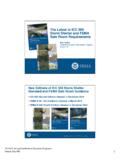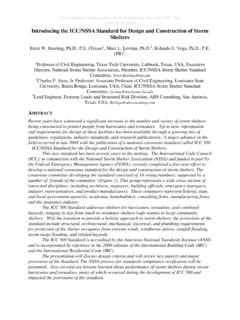Transcription of FEMA 361 FIRST EDITION July 2000 - Rhinovault
1 fema 361 FIRST EDITIONFIRST EDITIONM itigation emergency management AgencyJuly 2000 july 2000 DESIGN AND CONSTRUCTION GUIDANCE FOR COMMUNITY SHELTERSP refaceHaving personally seen the devastation caused by natural disasters, I amheartened to now see hundreds of communities commit to becoming disaster-resistant through fema s nationwide initiative, Project Impact. ProjectImpact operates on three simple principles: preventive actions must bedecided at the local level; private sector participation is vital; and long-termefforts and investments in prevention measures are essential. The FederalEmergency management agency is committed to continue to develop tools,such as this manual, to help individuals, communities, states, and others createsustainable, disaster-resistant severe weather threatens, individuals and families need to have a safeplace to go and time to get there.
2 Thousands of safe rooms have been builtbased on fema designs, providing protection for families in their will these people go if they are not at home? This manual providesspecific guidance on how to provide effective shelter that can save lives whensevere weather threatens away from L. WittDirector, federal emergency management AgencyiDESIGN AND CONSTRUCTION GUIDANCE FOR COMMUNITY SHELTERST able of ContentsProject xvAcronyms and xixChapter .. and Assessments, Research, and of the 1-5 Chapter 2 Protection Risk Levels and Life Assessment Wind Speed Map for Risk Assessmentand Shelter and Hurricane and Annual Event Existing Areas To Be Used as a Factors for Constructing a Tornadoor Hurricane emergency management AGENCYTABLE OF CONTENTSC hapter 3 Characteristics of Tornadoes and Wind Effects on Forces Tornadoes and of Extreme Winds and Tornado Generated by the Design Wind Failure Modes Elements, Connections,and Debris to Missile Debris and Other 4 Shelter Types, Location.
3 And Siting and Multi-Use and Retrofitting Existing Retrofitting Retrofitting Shelters for Shelters at Public Shelters on Building 4-9 Chapter 5 Load Determination and Structural Design of Previous Guidance, Research, and 5-1iiiDESIGN AND CONSTRUCTION GUIDANCE FOR COMMUNITY SHELTERSTABLE OF Design Research and Missile the Loads on the Extreme-Wind of Loads MWFRS and C& for Wind Calculation EquationsUsing ASCE 5-75. 4 Load Combinations .. Combinations Using Strength Combinations Using Allowable Stress Load Combination Load and Connections and Roof-to-Wall Connections and ConnectionsWithin Wall 6 Performance Criteria for Debris Loads and Successful Test Windborne Debris Debris (Missile) Potential at Shelter Loads From the Design Missile and Other Resistance of Wood Resistance of Sheet Resistance of Composite Wall Resistance of Concrete Masonry Units.
4 Resistance of Reinforced Falling and Door emergency management AGENCYTABLE OF and Egress ..6-20 Chapter 7 Additional Hazard Hazard Methods .. Design Hazard Protection and Life and Code Assurance/Quality Control 7-8 Chapter 8 Human Factors Footage/Occupancy Shelter Square Footage Shelter Square Footage Time and Americans with Disabilities Act (ADA).. and 8-7vDESIGN AND CONSTRUCTION GUIDANCE FOR COMMUNITY SHELTERSTABLE OF 8-9 Chapter 9 emergency management Considerations .. 9- Shelter Operations Site and Supplies .. Maintenance Building Shelter Operations Call Procedures for Safety of.
5 Signage at Schools and Places of 10 Design on the Design Design Wind Speeds for Tornadoes .. Design Wind Speeds for Wind Speeds for Probability of Exceeding Wind emergency management AGENCYTABLE OF on the Performance A Benefit/Cost Analysis Model for Tornado and Hurricane SheltersAppendix BSite Assessment ChecklistsAppendix CCase Study I Stand-Alone Community Shelter (North Carolina) Overview Wind Load Analysis Cost Estimate Operations Plan Design PlansAppendix DCase Study II School Shelter Design (Kansas) Overview Wind Load Analysis Cost Estimate Design PlansAppendix EWall Sections That Passed the Missile Impact TestsAppendix FDoors and Door Hardware That Passed the MissileImpact TestsAppendix GDesign Guidance on Missile Impact Protection Levels for WoodSheathingviiDESIGN AND CONSTRUCTION GUIDANCE FOR COMMUNITY SHELTERSTABLE OF CONTENTSF iguresChapter 1 IntroductionFigure 1-1 Small interior room that survived a 1-5 Chapter 2 Protection ObjectivesFigure 2-1 Risk assessment 2-3 Figure 2-2 Design wind speeds for community 2-5 Figure 2-3 Tornado occurrence in the United States based onhistorical 2-8 Figure 2-4 Flowchart for the benefit/cost 3 Characteristics of Tornadoes and HurricanesFigure 3-1 Calculated pressures
6 (based on ASCE 7-98 C&Cequations) acting on a typical 3-9 Figure 3-2 Internal pressurization and resulting building failure due todesign winds entering an opening in the windward 3-3 Forces on a building due to wind moving aroundthe 4 Shelter Types, Location, and Siting ConceptsFigure 4-1 The Denver International Airport (a public-use facility)evaluated the tornado risk at the airport site and identifiedthe best available areas of 4-4 Figure 4-2 Improperly sited 4-3 Properly sited shelter..4-11 Chapter 5 Load Determination and Structural CriteriaFigure 5-1 Shelter design 5-4 Figure 5-2 MWFRS combined loads and C&C loads actingon a structural 5-6 Figure 5-3 Comparison of tributary and effective wind areasfor a roof supported by open-web steel emergency management AGENCYTABLE OF CONTENTSF igure 5-4 Critical connections important for providing acontinuous load path in a typical masonry, concrete.
7 Or metal-frame building 5-5 Continuous load path in a reinforced masonrybuilding with a concrete roof 5-6 Failure in this load path occurred between the bondbeam and the top of the unreinforced masonry 5-7 These two steel columns failed at their connectionto the 6 Structural Performance CriteriaFigure 6-1 Wood 2x4 launched at 100 mph pierced unreinforcedmasonry wall, WERC, Texas Tech University.. 6-3 Figure 6-2 Refrigerator pierced by windborne 6-3 Figure 6-3 Wall sections constructed of plywood and masonryinfill (a) and plywood and metal (b).. 6-7 Figure 6-4 Uses of expanded metal (a) and sheet metal (b)in wall 6-8 Figure 6-5 Composite wall section.. 6-9 Figure 6-6 Concrete masonry unit (CMU) wall 6-7 Reinforced concrete wall section (a), reinforcedconcrete waffle wall constructed with insulating concrete forms (b), and reinforced concrete flat wall constructed with insulating concrete forms (c).
8 6-11 Figure 6-8 The door of the shelter in Case Study I (Appendix C)is protected by a missile-resistant 7 Additional 7-1 Figure 7-1 Examples of buildings with regular and irregular 7-3 Figure 7-2 Time response of ground during seismic 7-3 Figure 7-3 Example of single-degree-of-freedom system.. 7-4 Figure 7-4 Acceleration vs. period of 7-4ixDESIGN AND CONSTRUCTION GUIDANCE FOR COMMUNITY SHELTERSTABLE OF CONTENTSC hapter 9 emergency management ConsiderationsFigure 9-1 Example of a wind shelter 10 Design CommentaryFigure 10-1 Variations of impact impulse as a function of impact 10-2 Raw and filtered forcing functions measured using impactplate for impact from a 2x4 moving at 10-3 Impulse as a function of initial missile momentum for 3 Characteristics of Tornadoes and HurricanesTable Fujita 3-3 Table Saffir-Simpson Hurricane 3-6 Table of Previous Research on Probable Missile Speedsfor a 15-lb Wood 2x4 Missile as Associated With theDesign Wind Speeds From Figure 6 Structural Performance CriteriaTable Debris (Missiles)
9 And DebrisClassifications for Tornadoes and 6-4 Chapter 9 emergency management ConsiderationsTable Equipment and 9-6 Chapter 10 Design CommentaryTable Speeds Associated With the Fujita Frequencies for the United States (1900 1994)..10-4 Table Hurricane emergency management AGENCYTABLE OF CONTENTSF ormulasChapter 5 Load Determination and Structural Design CriteriaFormula 5-9 Formula on MWFRS for Low-Rise 5-9 Formula on C&C and 10 Design CommentaryFormula AND CONSTRUCTION GUIDANCE FOR COMMUNITY SHELTERSP roject TeamThe Project Team comprised engineers from fema s Mitigation Directorate,consulting design engineering firms, and university research institutions. Therole of the Project Team was to follow the plan indicated by the ConceptualReport and produce this guidance manual.
10 All engineering and testing effortsrequired to complete this project were performed by the Project Oliver, CEM, CBCPC hief Building Sciences and Assessment Branch, Mitigation DirectoratePaul Tertell, Officer and Senior Engineer Building Sciences and AssessmentBranch, Mitigation DirectorateCONSULTANTSW illiam Coulbourne, Structural Engineer and Department Head Natural Hazards Engineering,Greenhorne & O Mara, Kiesling, , of Shelter Program, Wind Engineering Research Center Texas TechUniversityDaniel Medina, , Dewberry & Davis, LLCK ishor Mehta, , , Wind Engineering Research Center Texas Tech UniversityShane Parson, Resources Engineer Dewberry & Davis, LLCR obert PendleyTechnical Writer Greenhorne & O Mara, Schiff, Professor of Civil Engineering Clemson UniversityScott Tezak, Manager, Structural Engineer Greenhorne & O Mara, AND CONSTRUCTION GUIDANCE FOR COMMUNITY SHELTERSA cknowledgmentsThe American Red Cross, Clemson University, ICC, Texas Tech University,and the Department of Education assisted fema in the preparation ofthis manual by providing invaluable guidance and participating on the projectReview Committee.





